Noise music is a genre of music that is characterised by the expressive use of noise within a musical context. This type of music tends to challenge the distinction that is made in conventional musical practices between musical and non-musical sound. Noise music includes a wide range of musical styles and sound-based creative practices that feature noise as a primary aspect.

James Tenney was an American composer and music theorist. He made significant early musical contributions to plunderphonics, sound synthesis, algorithmic composition, process music, spectral music, microtonal music, and tuning systems including extended just intonation. His theoretical writings variously concern musical form, texture, timbre, consonance and dissonance, and harmonic perception.
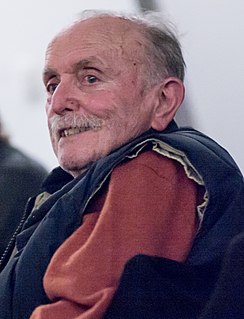
Alvin Augustus Lucier Jr. was an American composer of experimental music and sound installations that explore acoustic phenomena and auditory perception. A long-time music professor at Wesleyan University in Middletown, Connecticut, Lucier was a member of the influential Sonic Arts Union, which included Robert Ashley, David Behrman, and Gordon Mumma. Much of his work is influenced by science and explores the physical properties of sound itself: resonance of spaces, phase interference between closely tuned pitches, and the transmission of sound through physical media.

Pauline Oliveros was an American composer, accordionist and a central figure in the development of post-war experimental and electronic music.
Joan Linda La Barbara is an American vocalist and composer known for her explorations of non-conventional or "extended" vocal techniques. Considered to be a vocal virtuoso in the field of contemporary music, she is credited with advancing a new vocabulary of vocal sounds including trills, whispers, cries, sighs, inhaled tones, and multiphonics.
David Rosenboom is an American composer and a pioneer in the use of neurofeedback, cross-cultural collaborations and compositional algorithms. Working with Don Buchla, he was one of the first composers to use a digital synthesizer.
Frog Peak Music is a composer's collective that produces and distributes experimental works, and functions as a home for its artists. It was co-founded in 1984 by Jody Diamond and Larry Polansky.
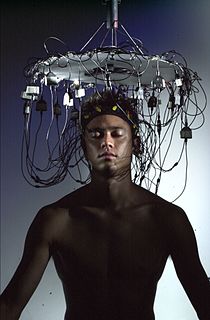
An electroencephalophone or encephalophone is an experimental musical instrument and diagnostic tool which uses brain waves to generate or modulate sounds.
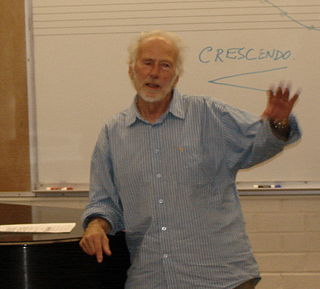
Raymond Murray Schafer was a Canadian composer, writer, music educator, and environmentalist perhaps best known for his World Soundscape Project, concern for acoustic ecology, and his book The Tuning of the World (1977). He was the first recipient of the Jules Léger Prize in 1978.

Chaim Moshe Tzadik Palestine, known professionally as Charlemagne Palestine, is an American visual artist and musician. He has been described as being one of the founders of New York school of minimalist music, first initiated by La Monte Young, Terry Riley, Philip Glass, Steve Reich and Phil Niblock, although he prefers to call himself a maximalist.
Sound art is an artistic activity in which sound is utilized as a primary medium or material. Like many genres of contemporary art, sound art may be interdisciplinary in nature, or be used in hybrid forms. According to Brandon LaBelle, sound art as a practice "harnesses, describes, analyzes, performs, and interrogates the condition of sound and the process by which it operates."
Hildegard Westerkamp is a Canadian composer, radio artist, teacher and sound ecologist of German origin. She studied flute and piano at the Conservatory of Music in Freiburg, West Germany from 1966 to 1968 and moved to Canada in 1975. She received a Bachelor of Music from the University of British Columbia in 1972 and a Master of Arts from Simon Fraser University in 1988. She taught acoustic communication at Simon Fraser University from 1982 to 1991.
Audiovisual art is the exploration of kinetic abstract art and music or sound set in relation to each other. It includes visual music, abstract film, audiovisual performances and installations.
Experimental music is a general label for any music or music genre that pushes existing boundaries and genre definitions. Experimental compositional practice is defined broadly by exploratory sensibilities radically opposed to, and questioning of, institutionalized compositional, performing, and aesthetic conventions in music. Elements of experimental music include indeterminate music, in which the composer introduces the elements of chance or unpredictability with regard to either the composition or its performance. Artists may also approach a hybrid of disparate styles or incorporate unorthodox and unique elements.
Within the field of neurotechnology, Neurofeedback (NFB), also called neurotherapy, neurobiofeedback or EEG biofeedback (EEGBF) is a therapy technique which presents the user with real-time information about activity within their brain, as measured by electrical or blood-flow sensors on the scalp.

The Association for Applied Psychophysiology and Biofeedback (AAPB) was founded in 1969 as the Biofeedback Research Society (BRS). The association aims to promote understanding of biofeedback and advance the methods used in this practice. AAPB is a non-profit organization as defined in Section 501(c)(6) of the Internal Revenue Service Code.
Thomas Hice Budzynski was an American psychologist and a pioneer in the field of biofeedback, inventing one of the first electromyographic biofeedback training systems in the mid-1960s. In the early 1970s, he developed the Twilight Learner in collaboration with John Picchiottino. The Twilight Learner was one of the first neurotherapy systems.
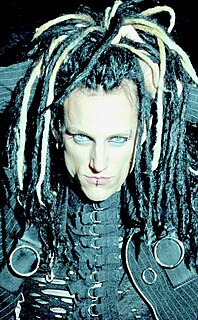
Matthew Setzer is a musician/music technologist living in Los Angeles.
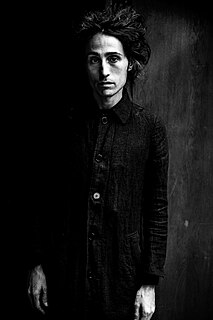
Massimilian Breeder is an Italian artist who works in film, drawings, sound and installation. He spent his childhood with his grandparents between Genova, Italy and Polperro, England. In 1992 he returned to Italy to study at the Paul Klee Institute for the Arts, followed by Neuroscience Studies at the University of Florence, where he began working on neural networks and biofeedbacks research, while developing interests in films and sculptural installations. He presented the first model of interaction between Cinema and Neuroscience at the prestigious Hôpital de la Salpêtrière in Paris, implementing the use of biofeedback technology to modulate and change the course of the narrative structure of a film. The project was titled Amigdalae and its development characterized Mr. Breeder's fascination with moving pictures. In 2002, he graduated with a degree in Experimental Psychology and began Cinema Studies at the National School of Cinema in Milan, which he would later abandon to move to New York City and work on his film projects * . Massimilian Breeder currently lives and works in Arenzano (GE).
Jacqueline Humbert is an American recording, performance and visual artist, as well as a designer for film, television and live performing arts. Under the name J. Jasmine, she recorded a song cycle, J Jasmine: My New Music which dealt progressively with topics such as androgyny and female sexual agency. The cycle was presented at the Ann Arbor Film Festival in 1978. Her artistic persona on this release has been described as "a Linda Ronstadt for the avant garde". She would collaborate again with Rosenboom in 1979–80 on the song cycle Daytime Viewing, which uses the framework of soap operas to deal with themes of commercialism, family, fashion, and abuse.









